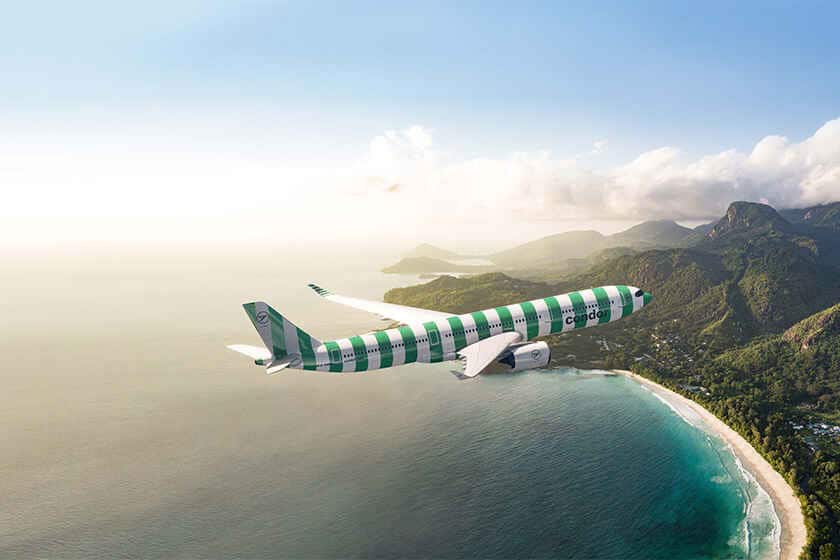Aviation
Germany’s Condor airline with a new brand identity

Condor is vacation. And vacation is stripes. Germany’s most popular leisure airline is unveiling its new brand identity today: In the future, Condor will wear stripes in five colors. Inspired by parasols, bath towels and beach chairs, Condor is evolving into a distinctive and unique vacation airline.
The corporate identity’s lead colors are yellow and blue. They have been complemented by the contrasting color gray. The Condor signet, the condor in a circle, goes back to one of Germany’s most influential designers, Otl Aicher. The figurative mark has been given a facelift, with finer and more dynamic lines. It can be found again in the tail unit of the aircraft. The Condor lettering has also been adapted: It is now more compact, and the new lower case has made the word mark more independent and consistent with the image. The logo appears in high-contrast black on the fuselage of the aircraft.
Initially, Condor‘s aircraft will carry five colors in a striped look: yellow, red, blue, green, and beige stand for the facets of the diversity of Condor’s guests, employees and the multitude of opportunities to discover the world with Condor.
The crew uniforms, accessories such as neckerchiefs, ties and pins will shine in the new design too, which will also make its way on board, to the airports, on the website and on social media: in the coming weeks and months, many items on board will be replaced, such as cups, blankets and cutlery, as well as all materials on the ground such as boarding passes, ID cards and airport signage. The replacement will run successively, with nothing of old design being disposed of, but everything being used up. Around 80 percent of the fleet is to be repainted by 2024, because new paint jobs are due anyway. Condor is thus choosing the most sustainable way to redesign its brand identity and fleet.
First A380 powered by 100% Sustainable Aviation Fuel takes to the skies
The new design was unveiled in Toulouse with the first A330neo, which will take off for Condor in the fall. The first 2-liter aircraft will of course take off with green stripes. As early as tomorrow, the first Condor aircraft in the new look will be on route: the Airbus A321 with the registration D-AIAD will wear yellow stripes and fly to Lanzarote on April 5 at noon. In the upcoming weeks, five more Boeing 757 and Airbus A320/1 aircrafts will be repainted, so that six aircrafts will be flying in the new design in the summer flight schedule. They will mainly fly to Mallorca, Greece, the Canary Islands and Egypt.

Aviation
Boeing, Antonov to Collaborate on Defense Projects

– MOU represents Boeing’s commitment to work with Ukrainian industry
– Includes exploring opportunities for collaborating on in-country support of Unmanned Aerial Systems
A Memorandum of Understanding was signed today by Boeing and Antonov Company to investigate potential collaboration on defense-related projects.
“We’re happy to keep collaborating with the Antonov Company to help Ukraine’s economic development and expansion,” stated Ted Colbert, CEO and president of Boeing Defence, Space, & Security.
Airbus and the Antonov An-225: The Best Partnership:Click here
“This agreement demonstrates our ongoing efforts to find more opportunities to work with Ukrainian industry, which was underscored by our signing of the Ukrainian Defence Industry Compact earlier this year.”
The areas of potential collaboration identified in the agreement consist of training, logistical support and overhaul services for tactical Unmanned Aerial Systems utilized by the Ukrainian Armed Forces, which includes the ScanEagle. In addition, the companies will also explore opportunities for Antonov to provide engineering support to Boeing.
The six largest cargo aircraft ever built in the aviation industry:Click here
“A strong, innovative, and efficient defense industry is key to sustainable economic development and national security, and we are extremely excited to collaborate with Boeing,” said Ievhen Gavrylov, CEO of Antonov Company.
This agreement brings a whole new level of opportunity to implement the latest and most effective solutions – in addition to the possibility of future projects with Boeing in the aerospace and defense industry.”
-

 Travel1 week ago
Travel1 week agoAir India to Expand US Operations with Three New Routes After a Decade
-

 Travel2 weeks ago
Travel2 weeks agoWhy We Should Avoid These Stamps in a Passport
-

 Airlines1 month ago
Airlines1 month agoInvestigations Reveal Fake Chinese Titanium in Boeing and Airbus Jets
-

 Tech4 weeks ago
Tech4 weeks agoChina’s CATL Plans 1,800-Mile Electric Plane Launch by 2027
-

 Airport3 days ago
Airport3 days agoTop 10 Largest Airports in the World by Size
-

 Aerospace4 weeks ago
Aerospace4 weeks agoChina’s Fighter Jets Turn Wings into Autonomous Drones
-

 Airlines4 days ago
Airlines4 days agoAir India Rolls Out A350s for Delhi-New York JFK and Newark Routes
-

 Defence3 weeks ago
Defence3 weeks agoBoeing Enhances Chinook with New Engines and Block II Upgrades at $96 Million







